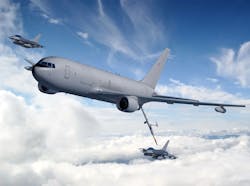Boeing team to provide 15 KC-46 aerial tanker aircraft, avionics, auxiliary power, and integrated displays
WRIGHT-PATTERSON AFB, Ohio – U.S. Air Force aerial refueling experts are asking the Boeing Co. to build 15 new KC-46 Pegasus military aerial refueling and strategic military transport aircraft under terms of a $2.2 billion order announced late last month.
Officials of the Air Force Life Cycle Management Center at Wright-Patterson Air Force Base, Ohio, are asking the Boeing Defense, Space & Security segment in Seattle to build lot 8 of the KC-46 aircraft program. The order includes subscriptions and licenses.
The KC-46 aircraft is based on the Boeing 767-200 widebody passenger jet. The multirole aerial tanker can refuel all U.S., allied, and coalition military aircraft compatible with international aerial refueling procedures. In addition to refueling other aircraft in midair, the KC-46 also can carry passengers, cargo, and medical patients.
The KC-46 aircraft can detect, avoid, defeat, and survive threats using several layers of electronic protection that enable it to operate safely in medium-threat environments, Boeing officials say.
Honeywell Aerospace, Northrop Grumman Corp., and Raytheon Technologies Corp. are among the companies providing avionics subsystems and components for the KC-46.
Honeywell Aerospace in Coon Rapids, Minn., provides the air data inertial navigation system for the KC-46, while the company's facility in Phoenix provides the auxiliary power unit. The Honeywell Aerospace facility in Tucson, Ariz., provides the KC-46 cabin pressure control system, while the company's facility in Urbana, Ohio, provides the tanker's lighting system.
The Northrop Grumman Electronic Systems segment in Rolling Meadows, Ill., provides the KC-46's Large Aircraft Infrared Countermeasures (LAIRCM), while the Raytheon Intelligence & Space segment in El Segundo, Calif., provides the tanker's digital radar warning receiver and digital anti-jam global positioning system (GPS) receiver.
The Raytheon Collins Aerospace segment in Cedar Rapids, Iowa, provides the KC-46 integrated display system with 15.1-inch diagonal liquid crystal displays, which are based on the avionics suite for the Boeing 787 Dreamliner passenger jet.
Related: KC-46 to be outfitted with new all-digital radar warning receivers
Collins Aerospace also provides the KC-46's tactical situational awareness system, remote vision system 3-D and 2-D technology for the boom operator, the communications, navigation, surveillance (CNI) system, networking, and flight-control systems.
The DRS Technologies Inc. Laurel Technologies Partnership in Johnstown, Pa., provides the KC-46's aerial refueling operator station (AROS). The Eaton Aerospace facility in Grand Rapids, Mich., provides the tanker's electromechanical and cargo door actuation systems.
Woodward Inc. in Skokie, Ill., meanwhile, provides the sensor system, control unit, and telescopic and flight control sticks for the KC-46-s aerial refueling boom.
GE Aviation Systems facilities in Grand Rapids, Mich., and Clearwater, Fla., provide the KC-46 mission control system avionics, which provide integrated communications management to support air traffic management data link, and enable the aircraft to perform with navigation precision not currently available to the tanker fleet.
GE Aviation also provides the KC-46 flight management system (FMS), which helps the aircraft fly relatively short flight paths and idle-thrust descents to reduce fuel consumption, while lowering emissions and reducing engine noise.
The KC-46 will replace the Air Force's fleet of KC-135 aerial refueling aircraft, which are based on the 1960s-vintage Boeing 707 four-engine passenger jet. Boeing will build as many as 179 KC-46 aircraft.
On this order Boeing will do the work in Seattle, and should be finished by November 2025. For more information contact Boeing Defense, Space & Security online at www.boeing.com, or the Air Force Life Cycle Management Center at www.aflcmc.af.mil.
About the Author
John Keller
Editor-in-Chief
John Keller is the Editor-in-Chief, Military & Aerospace Electronics Magazine--provides extensive coverage and analysis of enabling electronics and optoelectronic technologies in military, space and commercial aviation applications. John has been a member of the Military & Aerospace Electronics staff since 1989 and chief editor since 1995.
